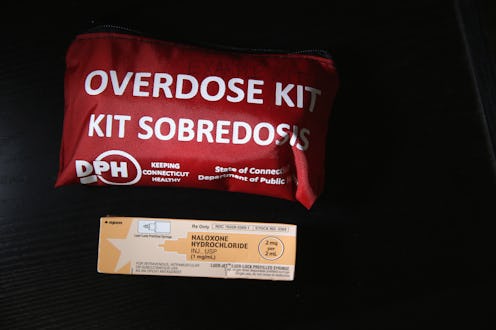Life
The Surgeon General Just Said ALL Americans Should Carry This Life-Saving Drug With Them

More than 115 people die every day in the U.S. from an opioid overdose, and now the U.S. Surgeon General, Dr. Jerome Adams, has issued the first surgeon general's advisory in more than a decade, asking all Americans to help carry naloxone, a life-saving drug that could help drive down opioid overdose deaths, CNN reported.
Naloxone, which is commonly sold under the brand name Narcan, works by blocking the effects of the opioid in the brain, according to WebMD. Naloxone does need to be followed up with emergency medical treatment from healthcare professionals, but in the event of an overdose, it is an effective stopgap to keep people alive until help can arrive, WebMD reported.
"[K]nowing how to use naloxone and keeping it within reach can save a life," Adams said in the advisory. He noted that the number of opioid overdose deaths doubled from 2010 to 2016, and attributed this increase to "the rapid proliferation of illicitly made fentanyl and other highly potent synthetic opioids," though the advisory also mentions that prescription opioid abuse is also responsible for overdose deaths.
Dr. Patricia Allen, Executive Director of Medical Services for Summit Behavioral Health, tells Bustle that Adams has taken a "bold step forward" in tackling an "epidemic [that killed] more than 62,000 individuals in 2017." Like Adams, she mentions fentanyl, explaining that though there are those who knowingly use fentanyl, "there [is] a dangerously growing number of individuals who are not aware that their drug of choice is laced with fentanyl," and that contributes to opioid overdose deaths.
"In my practice, we have seen many clients that thought they were smoking marijuana or using cocaine and found out it was mixed with fentanyl," Allen says. "Local police departments and emergency rooms are faced with this epidemic daily."
Adams emphasized that the everyday person has "an important role to play in addressing this public health crisis," and suggested people learn how to identify an opioid overdose and, if possible, obtain a naloxone kit to carry with them.
Obtaining a naloxone kit is fairly easy in the majority of states, USA TODAY reported, because naloxone access has been improved as concern about the opioid crisis increases. In most states, you do not need a prescription, and you do not need to be at risk of overdosing yourself in order to get naloxone. Allen says if someone close to you is has an addiction to any opiate, "Narcan is a must."
In many places, local pharmacies like CVS are capable of giving you a naloxone kit. CVS says on its website that naloxone is available from its pharmacists in both a nasal spray and as an injectable. In some cases, you may also be able to get naloxone from a local organization fighting overdoses.
It may be nerve-wracking to know you are carrying a tool to save a stranger's life, but there are training materials widely available to help you learn how to administer naloxone. "Treatment centers, outpatient clinics, emergency departments, doctor’s offices, schools, community centers are a sampling of places that offer training in recognizing an overdose and how to use Narcan in those situations," Allen explains. Plus, she says, administering naloxone isn't difficult. "The delivery system is simple, easy to use and is saving thousands of lives."
But you also need to know when to administer naloxone, which involves learning what signs indicate someone is on opioids, and what signs indicate someone has overdosed. According to the Harm Reduction Coalition, if someone is "really high," their pupils will contract, their muscles will be "slack and droopy," they may "nod out," and they may scratch their skin and have slurred speech. However, the critical difference between someone who is high and someone who is overdosing is that someone who's high "will respond to outside [stimuli] like loud noise or a light shake from a concerned friend," the coalition said on its website.
When someone has overdosed on opioids, they are likely to lose consciousness. If they remain conscious, they will probably not be able to talk, the coalition explained. They will be unresponsive to stimuli, may have breathing that is "very slow and shallow, erratic, or has stopped." The coalition also said to look out for lighter-skinned people turning bluish purple, and for darker-skinned people turning ashen. People overdosing may also vomit, have a "very limp" body, a pale, clammy face, and a pulse that is "slow, erratic, or not there at all." If you see someone experiencing these symptoms and you're carrying naloxone, the safest thing is to administer the drug, and then immediately call 9-1-1.
Even if you don't feel comfortable carrying naloxone, one thing is certain: The fact that the surgeon general has issued an advisory means he is asking members of the public to help one another survive. Allen says, "Dr. Adams' motto is 'better health through better partnerships.' He has [given] this country a call to action."
"Opioid addiction affects us all directly and indirectly," she adds. "Everyone has the ability to save a life."